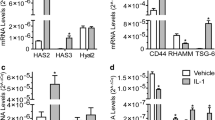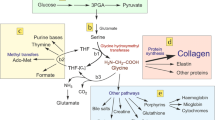Abstract
Previous work has shown that interleukin 1 (IL-1) increases the activity of acid extruders in articular chondrocytes, while the H+-adenosine triphosphatase (ATPase) inhibitor bafilomycin can prevent aggrecanase-mediated cartilage degradation. The H+ transport induced by IL-1 may therefore be required for proteinase activity. In the present study, the effects of hexosamines and fish oils on H+-ATPase activity have been characterised for isolated bovine articular chondrocytes. Cells isolated in the presence of IL-1 were acidified, and the fraction of acid extrusion mediated by Na+–H+ exchange and an H+-ATPase were determined using specific inhibitors. Exposure to IL-1 significantly enhanced both components of acid extrusion. Co-incubation with glucosamine or mannosamine attenuated the H+-ATPase fraction of efflux. The addition of glucosamine at 9 h after exposure to IL-1—when H+-ATPase activation is already apparent—was also able to abolish H+-ATPase activity, implying that hexosamines do not exert effects at the level of protein synthesis. Co-incubation with the glucose transport inhibitor phloretin elicited similar effects to the hexosamines, suggesting that modulation of adenosine triphosphate levels may underlie their effects on H+-ATPase function. The omega-3 fish oil linolenic acid but not the omega-6 fish oil linoleic acid reduced H+-ATPase activity to levels seen in IL-1-untreated cells, although total efflux remained elevated, as a result of an enhanced H+ leak. These observations support a model whereby IL-1 stimulates an H+-ATPase-dependent system, possibly involved in aggrecanase activation, which appears to be one of the target mechanisms interrupted by dietary supplements reported to have symptom-modifying effects on osteoarthritis.


Similar content being viewed by others
References
Amin AR, Abramson SB (1998) The role of nitric oxide in articular cartilage breakdown in osteoarthritis. Curr Opin Rheumatol 10:263–268
Dayer JM (2003) The pivotal role of interleukin-1 in the clinical manifestations of rheumatoid arthritis. Rheumatology (Oxford) 42(Suppl 2):ii3–ii10
Flannery CR, Little CB, Caterson B, Hughes CE (1999) Effects of culture conditions and exposure to catabolic stimulators (IL-1 and retinoic acid) on the expression of matrix metalloproteinases (MMPs) and disintegrin metalloproteinases (ADAMs) by articular cartilage chondrocytes. Matrix Biol 18:225–237
Pratta MA, Scherle PA, Yang G, Liu RQ, Newton RC (2003) Induction of aggrecanase 1 (ADAM-TS4) by interleukin-1 occurs through activation of constitutively produced protein. Arthritis Rheum 48:119–133
Sandy JD, Gamett D, Thompson V, Verscharen C (1998) Chondrocyte-mediated catabolism of aggrecan: aggrecanase-dependent cleavage induced by interleukin-1 or retinoic acid can be inhibited by glucosamine. Biochem J 335(Pt 1):59–66
Tattersall AL, Browning JA, Wilkins RJ (2005) Modulation of H+ transport mechanisms by interleukin-1 in isolated bovine articular chondrocytes. Cell Physiol Biochem 16:43–50
Yocum SA, Lopresti-Morrow LL, Gabel CA, Milici AJ, Mitchell PG (1995) Bafilomycin A1 inhibits IL-1-stimulated proteoglycan degradation by chondrocytes without affecting stromelysin synthesis. Arch Biochem Biophys 316:827–835
Neidel J, Zeidler U (1993) Independent effects of interleukin 1 on proteoglycan synthesis and proteoglycan breakdown of bovine articular cartilage in vitro. Agents Actions 39:82–90
Bliddal H, Christensen RD, Kristensen PK, Astrup AV (2006) [Glucosamine effectiveness in the treatment of knee osteoarthritis. Presentation of a Cochrane analysis with the perspective on the GAIT trial]. Ugeskrift for laeger 168:4405–4409
Herrero-Beaumont G, Ivorra JA, Del Carmen Trabado M, Blanco FJ, Benito P, Martin-Mola E, Paulino J, Marenco JL, Porto A, Laffon A, Araujo D, Figueroa M, Branco J (2007) Glucosamine sulfate in the treatment of knee osteoarthritis symptoms: a randomized, double-blind, placebo-controlled study using acetaminophen as a side comparator. Arthritis Rheum 56:555–567
Kremer JM (1996) Effects of modulation of inflammatory and immune parameters in patients with rheumatic and inflammatory disease receiving dietary supplementation of n-3 and n-6 fatty acids. Lipids 31(Suppl):S243–S247
Muller-Fassbender H, Bach GL, Haase W, Rovati LC, Setnikar I (1994) Glucosamine sulfate compared to ibuprofen in osteoarthritis of the knee. Osteoarthr Cartil 2:61–69
Noack W, Fischer M, Forster KK, Rovati LC, Setnikar I (1994) Glucosamine sulfate in osteoarthritis of the knee. Osteoarthr Cartil 2:51–59
Reginster JY, Deroisy R, Rovati LC, Lee RL, Lejeune E, Bruyere O, Giacovelli G, Henrotin Y, Dacre JE, Gossett C (2001) Long-term effects of glucosamine sulphate on osteoarthritis progression: a randomised, placebo-controlled clinical trial. Lancet 357:251–256
Rovati LC (1992) Clinical research in osteoarthritis: design and results of short-term and long-term trials with disease-modifying drugs. Int J Tissue React 14:243–251
Volker D, Fitzgerald P, Major G, Garg M (2000) Efficacy of fish oil concentrate in the treatment of rheumatoid arthritis. J Rheumatol 27:2343–2346
Curtis CL, Hughes CE, Flannery CR, Little CB, Harwood JL, Caterson B (2000) n-3 fatty acids specifically modulate catabolic factors involved in articular cartilage degradation. J Biol Chem 275:721–724
Fenton JI, Chlebek-Brown KA, Peters TL, Caron JP, Orth MW (2000) Glucosamine HCl reduces equine articular cartilage degradation in explant culture. Osteoarthr Cartil 8:258–265
Gouze JN, Bianchi A, Becuwe P, Dauca M, Netter P, Magdalou J, Terlain B, Bordji K (2002) Glucosamine modulates IL-1-induced activation of rat chondrocytes at a receptor level, and by inhibiting the NF-kappa B pathway. FEBS Lett 510:166–170
Patwari P, Kurz B, Sandy JD, Grodzinsky AJ (2000) Mannosamine inhibits aggrecanase-mediated changes in the physical properties and biochemical composition of articular cartilage. Arch Biochem Biophys 374:79–85
MacIntyre AC, Cutler DJ (1988) Role of lysosomes in hepatic accumulation of chloroquine. J Pharm Sci 77:196–199
Browning JA, Walker RE, Hall AC, Wilkins RJ (1999) Modulation of Na+ x H+ exchange by hydrostatic pressure in isolated bovine articular chondrocytes. Acta Physiol Scand 166:39–45
Wilkins RJ, Hall AC (1992) Measurement of intracellular pH in isolated bovine articular chondrocytes. Exp Physiol 77:521–524
Thomas JA, Buchsbaum RN, Zimniak A, Racker E (1979) Intracellular pH measurements in Ehrlich ascites tumor cells utilizing spectroscopic probes generated in situ. Biochemistry 18:2210–2218
Thomas RC (1984) Experimental displacement of intracellular pH and the mechanism of its subsequent recovery. J Physiol 354:3P–22P
Benos DJ (1982) Amiloride: a molecular probe of sodium transport in tissues and cells. Am J Physiol 242:C131–C145
Counillon L, Scholz W, Lang HJ, Pouyssegur J (1993) Pharmacological characterization of stably transfected Na+/H+ antiporter isoforms using amiloride analogs and a new inhibitor exhibiting anti-ischemic properties. Mol Pharmacol 44:1041–1045
Sundquist K (1993) Characterization of ATP-dependent proton transport in medullary bone-derived microsomes. Bone Miner 20:17–29
Tattersall A, Meredith D, Furla P, Shen MR, Ellory C, Wilkins R (2003) Molecular and functional identification of the Na(+)/H(+) exchange isoforms NHE1 and NHE3 in isolated bovine articular chondrocytes. Cell Physiol Biochem 13:215–222
Uldry M, Ibberson M, Hosokawa M, Thorens B (2002) GLUT2 is a high affinity glucosamine transporter. FEBS Lett 524:199–203
Mobasheri A, Neama G, Bell S, Richardson S, Carter SD (2002) Human articular chondrocytes express three facilitative glucose transporter isoforms: GLUT1, GLUT3 and GLUT9. Cell Biol Int 26:297–300
Windhaber RA, Wilkins RJ, Meredith D (2003) Functional characterisation of glucose transport in bovine articular chondrocytes. Pflugers Arch 446:572–577
Stefanovic-Racic M, Stadler J, Georgescu HI, Evans CH (1994) Nitric oxide and energy production in articular chondrocytes. J Cell Physiol 159:274–280
Buttgereit F, Brand MD (1995) A hierarchy of ATP-consuming processes in mammalian cells. Biochem J 312(Pt 1):163–167
Kane PM (1995) Disassembly and reassembly of the yeast vacuolar H(+)-ATPase in vivo. J Biol Chem 270:17025–17032
Gao G, Westling J, Thompson VP, Howell TD, Gottschall PE, Sandy JD (2002) Activation of the proteolytic activity of ADAMTS4 (aggrecanase-1) by C-terminal truncation. J Biol Chem 277:11034–11041
Considine MJ, Goodman M, Echtay KS, Laloi M, Whelan J, Brand MD, Sweetlove LJ (2003) Superoxide stimulates a proton leak in potato mitochondria that is related to the activity of uncoupling protein. J Biol Chem 278:22298–22302
Jump DB, Clarke SD (1999) Regulation of gene expression by dietary fat. Annu Rev Nutr 19:63–90
Acknowledgements
ALT held a MRC Studentship.
Author information
Authors and Affiliations
Corresponding author
Rights and permissions
About this article
Cite this article
Tattersall, A.L., Wilkins, R.J. Effects of hexosamines and omega-3/omega-6 fatty acids on pH regulation by interleukin 1-treated isolated bovine articular chondrocytes. Pflugers Arch - Eur J Physiol 456, 501–506 (2008). https://doi.org/10.1007/s00424-007-0425-x
Received:
Accepted:
Published:
Issue Date:
DOI: https://doi.org/10.1007/s00424-007-0425-x




